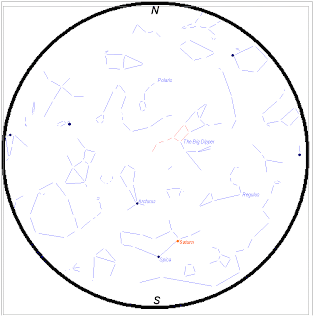.....It is hard to start off a column with an apology for two thousand years of common use (so I waited until the second paragraph! woo hoo!), but there is a habit that started with a Greek astronomer about 2300 years ago. This astronomer, Hipparchos, divided the stars in six categories with the brightest stars as "stars of the first rank" and the dimmest stars as "stars of the sixth rank". This seems to make sense until we track this this forward into the nineteenth century, and people are able to take photographs of stars and make absolute measurements of the amount of light coming from a particular star, as opposed to simply "brighter than that other star over there", when astronomers decided to keep the magnitude system.
.....This means that a star with a magnitude of 6.00 is the faintest star that can be seen with the naked eye (I normally use "unaided", but I want this blog to show up under Google searches for 'naked'; heck - naked naked naked) and a star with a magnitude of 1.00 is quite bright. The Sun has an apparent magnitude of -28. This can be hard to track. Still, at this level, we can still use the magnitude system in a reasonable way.
.....Consider this map below, which is the June 2011 sky as it might appear in a magazine such as Astronomy or Sky & Telescope, which shows stars down to fifth magnitude (going all the way to sixth magnitude would add about 1,600 tiny dots to the map; not a great deal of use is added.
.....Drat. I just noticed that I did not add Saturn to the empty star maps.















 .....The Moon enters the umbra, the central shadow at 12:51 AM (again, CST, the best time zone) , and totality, with the Moon entirely in the umbra from 1:57 AM to 3:14 AM. On Earth, a total eclipse is completely dark, but in a lunar eclipse the light passing through the Earth's atmosphere is scattered into the shadow. In the same way that the sky appears blue because blue light is scattered first, and the setting Sun appears red because red light is scattered last, the totally eclipsed Moon will appear a deep red, sometimes getting so faint that the full &^$%&^% Moon is hard to find in the sky.
.....The Moon enters the umbra, the central shadow at 12:51 AM (again, CST, the best time zone) , and totality, with the Moon entirely in the umbra from 1:57 AM to 3:14 AM. On Earth, a total eclipse is completely dark, but in a lunar eclipse the light passing through the Earth's atmosphere is scattered into the shadow. In the same way that the sky appears blue because blue light is scattered first, and the setting Sun appears red because red light is scattered last, the totally eclipsed Moon will appear a deep red, sometimes getting so faint that the full &^$%&^% Moon is hard to find in the sky.






